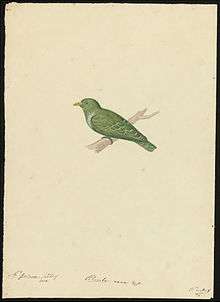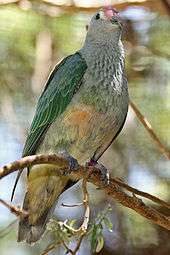Fruit dove
| Fruit doves | |
|---|---|
| | |
| Jambu fruit dove, Ptilinopus jambu | |
| Scientific classification | |
| Kingdom: | Animalia |
| Phylum: | Chordata |
| Class: | Aves |
| Order: | Columbiformes |
| Family: | Columbidae |
| Genus: | Ptilinopus Swainson, 1825 |
| Species | |
|
About 50, see article | |
| Synonyms | |
|
Chrysoenas | |
The fruit doves, also known as fruit pigeons, are a genus (Ptilinopus) of birds in the pigeon and dove family (Columbidae). These colourful, frugivorous doves are found in forests and woodlands in Southeast Asia and Oceania. It is a large genus with about 50 species, some threatened or already extinct.[1]
Description
These small- to medium-sized doves generally have short, fan-shaped tails,[2] and are remarkable for their colourful and often glossy plumage, as evidenced in the aptly named orange fruit dove, flame-breasted fruit dove, and pink-headed fruit dove.[1] Males and females of many fruit dove species look very different. For example, the female many-coloured fruit dove shares the male’s crimson crown and deep pink undertail feathers, but is otherwise green, whereas the male has a crimson on the upper back and has areas of yellow, olive, cinnamon, and grey.[1][2]
Distribution, behaviour, and habitat
This is a large genus, most diverse in and around the island of New Guinea, in the Philippines, and in the biogeographical region of Wallacea. Some species have ranges as far west as the Sunda Islands, others north to Taiwan, south to Australia, and east into Polynesia.
Fruit doves, as their name implies, eat fruit—ficus is especially important[2]—and live in various kinds of forest or woodland. Some species are restricted to primary forest, such as lowland rainforest, montane forest, or monsoon forest, while others prefer secondary forest or disturbed areas. Some species specialize in particular habitats, from lowland coastal forest to the cloud forest or moss forest of high altitudes. Some species of fruit doves are only found in habitats dominated by particular plants, such as mangrove, eucalyptus, or pandanus. Only a few species can commonly be seen around human habitation, these include the knob-billed fruit dove, Makatea fruit dove, and black-naped fruit dove, which are known to visit gardens and such.[1]
Much is still to be learned about fruit doves. Many species are shy and difficult to observe in their natural habitat. For example, there are several species in the Philippines, and for most of them, little or nothing is known of their breeding or nesting behavior.[3]
Taxonomy
The many species of this genus can be further grouped by geography and by certain shared characteristics. The fruit doves of the Sunda Islands and northern Australia, such as the pink-headed fruit dove and banded fruit dove, have comparatively longer tails than other species, and are notable for their solid colouration on the head, neck and breast, with a black band across the belly. Another grouping can be made of certain fruit doves endemic to New Guinea, the Moluccas, and the Bismarck Archipelago, including the carunculated fruit dove, knob-billed fruit dove, and others; these are notable for their grey colouration on the head or shoulder and/or enlarged cere (part of the bill). This group is uncharacteristically not sexually dimorphic, meaning males and females look alike. The orange dove, golden dove, and whistling dove, all endemic to Fiji and sometimes placed in their own genus Chrysoenas, have in common their small size, compact shape, yellow or orange colouration in the males, and hair-like body feathers. They also are known for their rather un-pigeon-like vocalizations, which sound like snapping, barking, or whistling, respectively.[1] Finally, the Pacific Islands provide homes to a number of species that share generally green colouration with crimson caps or crowns, ventriloquial cooing or hooting, and a distinct texture of the breast feathers.[2] The grey-green fruit dove is typical of this group.[1] Recent evidence suggests Ptilinopus as presently defined is paraphyletic as Alectroenas and Drepanoptila are embedded within it.[4] The generic name Ptilinopus comes from the Ancient Greek words ptilon "feather," and pous, "foot."[5]
Species

- Banded fruit dove, Ptilinopus cinctus
- Black-banded fruit dove, Ptilinopus alligator
- Red-naped fruit dove, Ptilinopus dohertyi
- Pink-headed fruit dove, Ptilinopus porphyreus
- Flame-breasted fruit dove, Ptilinopus marchei
- Cream-breasted fruit dove, Ptilinopus merrilli
- Yellow-breasted fruit dove, Ptilinopus occipitalis
- Red-eared fruit dove, Ptilinopus fischeri
- Jambu fruit dove, Ptilinopus jambu
- Oberholser's fruit dove, Ptilinopus epia
- Banggai fruit dove, Ptilinopus subgularis
- Sula fruit dove, Ptilinopus mangoliensis
- Black-chinned fruit dove, Ptilinopus leclancheri
- Scarlet-breasted fruit dove, Ptilinopus bernsteinii
- Wompoo fruit dove, Ptilinopus magnificus
- Pink-spotted fruit dove, Ptilinopus perlatus
- Ornate fruit dove, Ptilinopus ornatus
- Tanna fruit dove, Ptilinopus tannensis
- Orange-fronted fruit dove, Ptilinopus aurantiifrons
- Wallace's fruit dove, Ptilinopus wallacii
- Superb fruit dove, Ptilinopus superbus
- Many-coloured fruit dove, Ptilinopus perousii
- Crimson-crowned fruit dove, Ptilinopus porphyraceus
- Ebon purple-capped fruit dove, Ptilinopus porphyraceus marshallianus - doubtfully distinct; extinct (late 19th century)?
- Purple-capped fruit dove, Ptilinopus ponapensis
- Kosrae fruit dove, Ptilinopus hernsheimi
- Palau fruit dove, Ptilinopus pelewensis
- Lilac-crowned fruit dove, Ptilinopus rarotongensis
- Mauke fruit dove, Ptilinopus rarotongensis "byronensis" - extinct (mid-/late 19th century)
- Tubuai fruit dove, Ptilinopus sp. - prehistoric
- Mariana fruit dove, Ptilinopus roseicapilla

- Rose-crowned fruit dove, Ptilinopus regina
- Silver-capped fruit dove, Ptilinopus richardsii
- Grey-green fruit dove, Ptilinopus purpuratus
- Makatea fruit dove, Ptilinopus chalcurus
- Atoll fruit dove, Ptilinopus coralensis
- Red-bellied fruit dove, Ptilinopus greyi
- Rapa fruit dove, Ptilinopus huttoni
- White-capped fruit dove, Ptilinopus dupetithouarsii
- Red-moustached fruit dove, Ptilinopus mercierii - extinct (mid-20th century)
- Henderson fruit dove, Ptilinopus insularis
- Coroneted fruit dove, Ptilinopus coronulatus
- Beautiful fruit dove, Ptilinopus pulchellus
- Blue-capped fruit dove, Ptilinopus monacha
- White-bibbed fruit dove, Ptilinopus rivoli
- Yellow-bibbed fruit dove, Ptilinopus solomonensis
- Claret-breasted fruit dove, Ptilinopus viridis
- White-headed fruit dove, Ptilinopus eugeniae

- Orange-bellied fruit dove, Ptilinopus iozonus
- Knob-billed fruit dove, Ptilinopus insolitus
- Grey-headed fruit dove, Ptilinopus hyogaster
- Carunculated fruit dove, Ptilinopus granulifrons
- Black-naped fruit dove, Ptilinopus melanospilus
- Dwarf fruit dove, Ptilinopus nainus
- Negros fruit dove, Ptilinopus arcanus - possibly extinct (late 20th century?)
- Orange fruit dove, Ptilinopus victor
- Golden fruit dove, Ptilinopus luteovirens
- Whistling fruit dove, Ptilinopus layardi
References
- 1 2 3 4 5 6 Gibbs, David; Barnes, Eustace; Cox, John (2001). Pigeons and Doves: A Guide to the Pigeons and Doves of the World. Yale University Press. pp. 120–144, 457–521. ISBN 0-300-07886-2.
- 1 2 3 4 Pratt, H. Douglas; et al. (1987). The Birds of Hawaii and the Tropical Pacific. Princeton University Press. pp. 196, 201–202. ISBN 0-691-02399-9.
- ↑ Kennedy, Robert S.; Gonzales, Pedro C.; Dickinson, Edward C.; Miranda, Hector C., Jr.; Fisher, Timothy H. (2000). A Guide to the Birds of the Philippines. Oxford University Press. pp. 138–141. ISBN 0-19-854668-8.
- ↑ Gibb, G.C., & D. Penny (2010). Two aspects along the continuum of pigeon evolution: A South-Pacific radiation and the relationship of pigeons within Neoaves. Mol Phyl Evol 56(2): 698-706.
- ↑ Liddell, Henry George; Scott, Robert (1980) [1871]. A Greek-English Lexicon (Abridged ed.). Oxford, United Kingdom: Oxford University Press. pp. 581, 615. ISBN 0-19-910207-4.